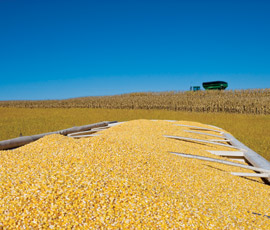Big US maize crop will pressure wheat prices

Maize production in the United States is set to exceed expectations while soya beans will fall short. An analyst from French consultancy group ODA joins a tour through the mid-western states to assess what this might mean for British growers
Better-than-expected maize crops in the United States are set to put downward pressure on wheat prices while the soya bean harvest will fall short of forecasts and could help support oilseed rape prices.
Feed wheat trading around £158/t at the end of August for a November contract is expect to fall by around £10/t over the next three weeks, says ODA analyst Leo von Kameke.
Meanwhile, the potential shortfall in soya bean yields, combined with the worsen political situation in Egypt and the euro falling against the dollar, could help oilseed rape prices.
He expects prices to increase by around £10/t in the coming weeks, although he believes the long-term outlook for rapeseed will see prices going lower.
Mr von Kameke joined a ProFarmer crop tour which aimed to assess maize and soya bean yields and travelled recently across the states of Iowa, Minnesota, Ohio, Illinois and Indiana.
“It is clear that many risks remain for crops across the United States and the weather over the next few weeks will be critical in determining the outcome of harvest,” he says.
The 2013 tour highlighted that while some maize and soya bean crops in eastern and central US are very good, huge variability exists in maturity, soil moisture and frost risks, giving cause for concern, he adds.
The ProFarmer group has reduced its yield estimates below current US Department of Agriculture (USDA) figures to reflect the vast unplanted areas in Iowa and Minnesota.
Assuming perfect growing conditions in September, the ProFarmer group estimates average US maize yields will be 154.1 bushels/acre, compared with 154.4 in the USDA’s latest report.
The group puts total maize production at 342m tonnes (13.46bn bushels) compared with the USDA’s estimate of 349m tonnes.
It estimates US soya bean yields at 41.8 bushels/acre, giving a total harvest of 80m tonnes (3.16bn bushels), compared with a USDA figure of 88.6m tonnes.
IOWA
The number one maize-producing state should generate 2.2bn bushels, based on a yield of 163 bushels/acre, according to the USDA.
The ProFarmer group estimates yields at 171.9 bushels/acre, above 2012’s 137 bushels/acre, but it reports many crops were planted late.
The state was also the largest soya bean producer in 2012, and 2013 production is estimated at 433.78m bushels, although late plantings make the crops more vulnerable to adverse weather.
The ProFarmer group found soya bean pod counts of 927 per three-foot square, 7% down on 2012, 22% below the three-year average and far short of the 1,200 required for optimum yields.
MINNESOTA
Mr von Kameke says large unplanted areas dominate the landscape, but established crops show good potential.
The ProFarmer group estimates the average yield at 181.1 bushels/acre, 16% up on 2012 and 5% above the three-year average, while the USDA predicts production at 1.36bn bushels.
He says soya beans are disappointing with the USDA estimating an average of 41 bushels/acre, down from 2012’s 43 bushels/acre, equating to production of 271.83m bushels.
OHIO
Hopes are high that increased production in the seventh-largest maize and soya bean producing state will help to offset shortfalls in Iowa and Minnesota.
The USDA estimates the average maize yield at 172 bushels/acre after 2012’s 123 bushels/acre in line with ProFarmer, while Mr von Kameke says soya bean population counts are encouraging.
ILLINOIS
The state ranked fourth in maize production in 2012 and could be second in 2013 based on the USDA’s area estimate and yield forecast of 165 bushels/acre.
Mr von Kameke expresses concern over variable crop maturity as crops are suffering from moisture/nitrogen deficiencies and without rain he says yields could fall 5-10%.
Illinois could be the largest soya bean producer in 2013, according to the USDA.
INDIANA
Indiana, the fifth-largest corn producing state, is set to produce 979,400 bushels in 2013, according to the USDA, up from 2012’s 596,970 based on higher yields.
The ProFarmer group found a soya bean pod count above those in 2012 and a three-year average, but expressed concern over extremely heavy weed populations.
Ideal weather helps soil to establish itself
